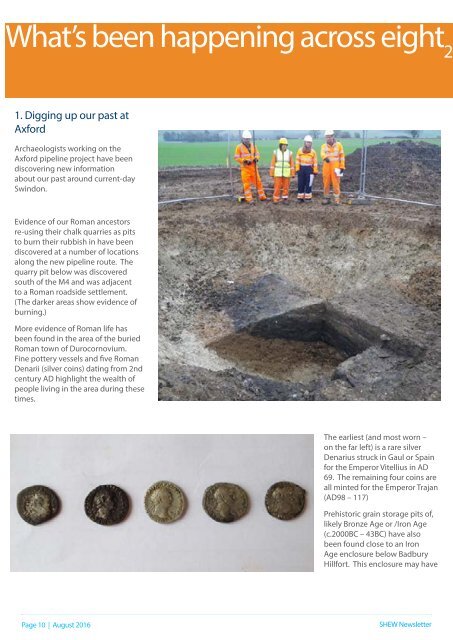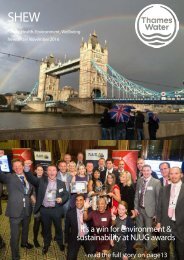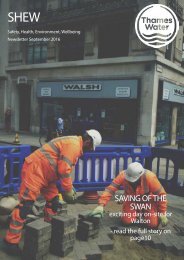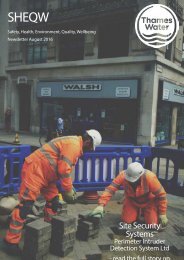SHEQWs Newsletter November
Create successful ePaper yourself
Turn your PDF publications into a flip-book with our unique Google optimized e-Paper software.
What’s been happening across eight 2<br />
O<br />
1. Digging up our past at<br />
Axford<br />
Archaeologists working on the<br />
Axford pipeline project have been<br />
discovering new information<br />
about our past around current-day<br />
Swindon.<br />
Evidence of our Roman ancestors<br />
re-using their chalk quarries as pits<br />
to burn their rubbish in have been<br />
discovered at a number of locations<br />
along the new pipeline route. The<br />
quarry pit below was discovered<br />
south of the M4 and was adjacent<br />
to a Roman roadside settlement.<br />
(The darker areas show evidence of<br />
burning.)<br />
More evidence of Roman life has<br />
been found in the area of the buried<br />
Roman town of Durocornovium.<br />
Fine pottery vessels and five Roman<br />
Denarii (silver coins) dating from 2nd<br />
century AD highlight the wealth of<br />
people living in the area during these<br />
times.<br />
2. Sharing knowledge<br />
between Utilities<br />
A fantastic demonstration of best<br />
practice sharing and collaboration<br />
between contracts, eight2O, tRIIO<br />
(joint venture for National Grid) and<br />
SQS (a tRIIO recycled aggregates<br />
supplier), occured this month.<br />
Members of the construction, design<br />
and procurement teams from both<br />
SMBJV and CABVJV attended a<br />
recent event to showcase recycled<br />
aggregates; increasing awareness of<br />
the production techniques, technical<br />
applications and ways to ensure a<br />
final quality product.<br />
Chris Stones, from SQS, talked<br />
through the process from when the<br />
waste aggregate is received at the<br />
site through to sorting, screening<br />
and finally production of the recycled<br />
aggregates, including Type 1, pea<br />
shingle and eco surround.<br />
The SQS team also demonstrated<br />
how recycled aggregates are used<br />
for reinstatement across all of<br />
their tRIIO contracts. Backfilling a<br />
specially prepared excavation they<br />
demonstrated how the material is<br />
tampered down and compacted<br />
and how this compaction is tested<br />
aggregates on their contract.<br />
Mark Guinn, Strata Highways,<br />
detailed the testing that is carried<br />
out on the recycled aggregates<br />
produced at SQS and on the<br />
stability and compaction of<br />
the material once it has been<br />
placed in the ground. Mark<br />
also explained the possible cost<br />
savings available if recycled<br />
aggregates are used.<br />
The day provided great learnings<br />
and experience that can be used<br />
on eight2O to increase the usage<br />
of recycled aggregates across our<br />
contracts.<br />
The earliest (and most worn –<br />
on the far left) is a rare silver<br />
Denarius struck in Gaul or Spain<br />
for the Emperor Vitellius in AD<br />
69. The remaining four coins are<br />
all minted for the Emperor Trajan<br />
(AD98 – 117)<br />
Prehistoric grain storage pits of,<br />
likely Bronze Age or /Iron Age<br />
(c.2000BC – 43BC) have also<br />
been found close to an Iron<br />
Age enclosure below Badbury<br />
Hillfort. This enclosure may have<br />
Page 10 | August 2016 SHEW <strong>Newsletter</strong><br />
SHEW <strong>Newsletter</strong><br />
August 2016 | Page 11
















